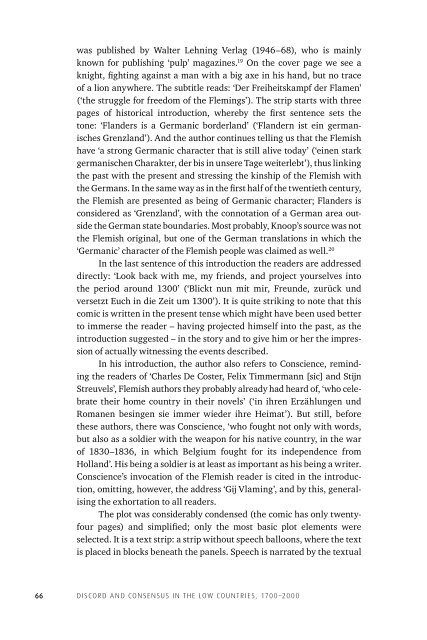Discord Consensus
7aze300jFJo
7aze300jFJo
Create successful ePaper yourself
Turn your PDF publications into a flip-book with our unique Google optimized e-Paper software.
was published by Walter Lehning Verlag (1946–68), who is mainly<br />
known for publishing ‘pulp’ magazines. 19 On the cover page we see a<br />
knight, fighting against a man with a big axe in his hand, but no trace<br />
of a lion anywhere. The subtitle reads: ‘Der Freiheitskampf der Flamen’<br />
(‘the struggle for freedom of the Flemings’). The strip starts with three<br />
pages of historical introduction, whereby the first sentence sets the<br />
tone: ‘Flanders is a Germanic borderland’ (‘Flandern ist ein germanisches<br />
Grenzland’). And the author continues telling us that the Flemish<br />
have ‘a strong Germanic character that is still alive today’ (‘einen stark<br />
germanischen Charakter, der bis in unsere Tage weiterlebt’), thus linking<br />
the past with the present and stressing the kinship of the Flemish with<br />
the Germans. In the same way as in the first half of the twentieth century,<br />
the Flemish are presented as being of Germanic character; Flanders is<br />
considered as ‘Grenzland’, with the connotation of a German area outside<br />
the German state boundaries. Most probably, Knoop’s source was not<br />
the Flemish original, but one of the German translations in which the<br />
‘Germanic’ character of the Flemish people was claimed as well. 20<br />
In the last sentence of this introduction the readers are addressed<br />
directly: ‘Look back with me, my friends, and project yourselves into<br />
the period around 1300’ (‘Blickt nun mit mir, Freunde, zurück und<br />
versetzt Euch in die Zeit um 1300’). It is quite striking to note that this<br />
comic is written in the present tense which might have been used better<br />
to immerse the reader –having projected himself into the past, as the<br />
introduction suggested –in the story and to give him or her the impression<br />
of actually witnessing the events described.<br />
In his introduction, the author also refers to Conscience, reminding<br />
the readers of ‘Charles De Coster, Felix Timmermann [sic] and Stijn<br />
Streuvels’, Flemish authors they probably already had heard of, ‘who celebrate<br />
their home country in their novels’ (‘in ihren Erzählungen und<br />
Romanen besingen sie immer wieder ihre Heimat’). But still, before<br />
these authors, there was Conscience, ‘who fought not only with words,<br />
but also as a soldier with the weapon for his native country, in the war<br />
of 1830–1836, in which Belgium fought for its independence from<br />
Holland’. His being a soldier is at least as important as his being a writer.<br />
Conscience’s invocation of the Flemish reader is cited in the introduction,<br />
omitting, however, the address ‘Gij Vlaming’, and by this, generalising<br />
the exhortation to all readers.<br />
The plot was considerably condensed (the comic has only twenty-<br />
four pages) and simplified; only the most basic plot elements were<br />
selected. It is a text strip: a strip without speech balloons, where the text<br />
is placed in blocks beneath the panels. Speech is narrated by the textual<br />
66<br />
DISCORD AND CONSENSUS IN THE LOW COUNTRIES, 1700–2000


